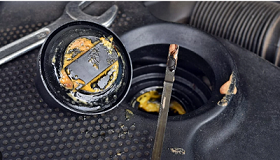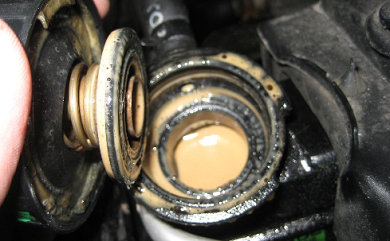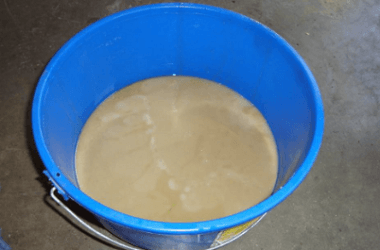Fix milky oil in the engine by identifying the source of contamination and addressing the issue promptly. Properly diagnose the problem to determine whether it is caused by coolant leakage, a blown head gasket, or water condensation, and take appropriate steps to resolve it.
Engine oil should ideally be transparent or light brown in color, indicating that it is clean and free from contaminants. However, if you notice a milky appearance in the engine oil, it is a clear indication of a problem. We will discuss the possible causes of milky oil in the engine and provide effective solutions to fix the issue.
By understanding the underlying problem and taking prompt action, you can prevent further damage to your engine and ensure its smooth operation.
Common Causes Of Milky Oil In Engine
Water contamination is one of the common causes of milky oil in an engine. When water enters the engine oil, it can create a milky appearance and affect the lubrication properties of the oil. This contamination can occur due to coolant leak or condensation build-up.
A coolant leak happens when there is a breach in the cooling system, allowing coolant to mix with the engine oil. This can be caused by a faulty gasket, cracked cylinder head, or a damaged radiator. It is essential to identify and fix the source of the leak to prevent further damage to the engine.
Condensation build-up occurs when there are temperature fluctuations or short trips where the engine does not reach operating temperature. This leads to moisture build-up inside the engine, which can mix with the oil. Regularly driving the vehicle for longer distances or using a crankcase breather can help reduce condensation.

It is crucial to address the milky oil issue promptly, as it can lead to engine damage and decreased performance. Consult a professional mechanic to diagnose the problem accurately and fix it using appropriate measures.
Signs Of Milky Oil In Engine
Signs of milky oil in the engine include a frothy oil dipstick, increased engine temperature, and white smoke from the exhaust pipe. When you check the dipstick, the oil may appear light brown or milky in color due to water or coolant mixing with the oil.
This can be caused by a blown head gasket or a cracked engine block allowing coolant to seep into the oil passages. The presence of water in the oil reduces its lubricating properties, potentially leading to engine damage.
The coolant mixing with the oil can also create a frothy appearance on the dipstick. Increased engine temperature may indicate a cooling system failure, causing coolant to leak into the oil.

Finally, white smoke from the exhaust pipe is a common symptom of coolant entering the combustion chamber, which should be addressed promptly to avoid further engine damage.
Step-by-step Guide To Fix Milky Oil In Engine
Step-by-Step Guide to Fix Milky Oil in Engine
To fix milky oil in your engine, follow these steps:
- Drain and replace oil: Start by draining the milky oil from the engine completely. Then, replace it with fresh oil that is recommended for your vehicle.
- Inspect and repair coolant system: Check the coolant system for any leaks or damages. Fix any issues found and ensure proper functioning of the system.
- Check for coolant leaks: Examine all connections, hoses, and seals for any coolant leaks. If leaks are identified, repair or replace the faulty components.
- Flush the engine: Perform an engine flush to remove any remaining coolant contamination. Follow the instructions provided by the manufacturer or consult a professional if needed.
- Test and monitor engine performance: After completing the above steps, start the engine and monitor its performance. Keep an eye on the oil for any signs of coolant contamination, and address any further issues that may arise.
By following these steps, you can effectively fix the milky oil in your engine and ensure proper engine functioning.
Regular Maintenance Practices
Regular maintenance practices are crucial to preventing milky oil in the engine. One of the main steps is to change the oil and filter according to the manufacturer’s recommendations. This ensures that the oil is clean and free from contaminants that could lead to engine damage.
It is important to inspect and maintain the coolant system. Checking the coolant levels regularly can help identify any leaks or issues that may contribute to milky oil.
Keeping the coolant system in good condition is vital for proper engine function and heat regulation. By following these maintenance practices, you can avoid milky oil in the engine and extend the life of your vehicle.
Protective Measures
Protective Measures:
- Use high-quality coolant to prevent the formation of milky oil in your engine.
- Park your vehicle in a covered garage or sheltered area to protect it from extreme temperatures and moisture.
- Avoid frequent short trips in cold weather, as this can prevent your engine from reaching its optimal operating temperature and lead to condensation inside the engine.
Additional Tips:
- Regularly check your coolant levels and top up if necessary.
- Make sure your vehicle’s cooling system is properly maintained, including regular coolant flushes and radiator inspections.
- If you notice milky oil in your engine, consult a professional mechanic to diagnose and fix the underlying issue.
By following these protective measures and taking proper care of your vehicle’s cooling system, you can prevent the formation of milky oil in your engine and ensure its optimal performance and longevity.

Credit: www.the-sun.com
Frequently Asked Questions For How To Fix Milky Oil In Engine
How Does Milky Oil In The Engine Happen?
Milky oil in the engine can occur when coolant mixes with the oil. This could be due to a blown head gasket, cracked engine block or a faulty oil cooler. It is crucial to address the issue promptly as it can lead to severe engine damage if left untreated.
What Are The Symptoms Of Milky Oil In The Engine?
Symptoms of milky oil in the engine include a foamy or milky appearance on the dipstick, overheating, white exhaust smoke, loss of coolant, and engine misfires. If you notice any of these signs, it is important to take immediate action to prevent further damage to the engine.
How Can I Fix Milky Oil In The Engine?
To fix milky oil in the engine, first identify and repair the underlying issue causing the coolant to mix with the oil. This may involve replacing the head gasket, repairing the cracked engine block, or fixing a faulty oil cooler.
After the repairs are completed, change the oil and coolant, ensuring there is no contamination. Regular monitoring and maintenance can prevent future occurrences.

Can I Still Drive With Milky Oil In The Engine?
Driving with milky oil in the engine is not recommended, as it can lead to severe damage. The coolant mixing with the oil reduces its lubricating properties, potentially causing increased friction and wear on engine components. It is best to have the issue inspected and repaired by a professional mechanic before continuing to drive the vehicle.
Conclusion
To sum up, fixing milky oil in the engine is crucial for the overall performance and longevity of your vehicle. By identifying the root cause, such as a blown head gasket or water contamination, and taking appropriate actions, such as replacing necessary parts or performing thorough flushes, you can restore the oil’s clarity and ensure optimal engine health.
Regular maintenance and inspections will help prevent this issue in the future, saving you from costly repairs. Stay proactive and prioritize the well-being of your engine.


Leave a Reply